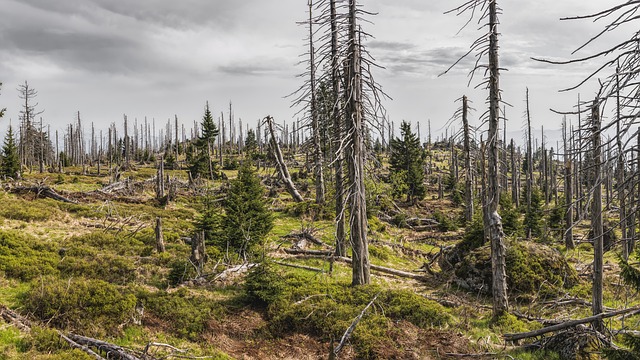Forest management in Lane County, Oregon has evolved from intensive clear-cutting to sustainable practices focused on biodiversity conservation and long-term timber yield. This shift, driven by environmental awareness, balances human economic needs with ecological integrity, ensuring the region's forest health and economic diversification beyond traditional timber dependence. Modern techniques include selective cutting, reforestation, and collaborative efforts between industry, conservationists, and local authorities.
“Lane County, Oregon, has witnessed a remarkable evolution in its timber industry, reflecting broader changes in forest management practices. This article delves into the historical harvest methods that once shaped the county’s forests, exploring their contrast with modern techniques. We trace the impact of industrialization on local ecosystems and highlight conservation efforts that have promoted sustainability. By comparing present-day timber practices to historical trends, we gain insights into how Lane County has adapted its forest management strategies over time.”
- Historical Timber Harvesting Practices in Lane County
- Evolution of Forest Management Techniques Over Time
- The Impact of Industrialization on Local Forests
- Conservation Efforts and Their Role in Sustainability
- Present-Day Timber Industry vs Historical Trends
Historical Timber Harvesting Practices in Lane County

In the historical landscape of Lane County, Oregon, timber harvesting practices have evolved significantly over time, reflecting broader shifts in forest management strategies. Early methods were largely driven by the need for sustenance and construction materials, leading to extensive clear-cutting and selective logging. These practices, while providing immediate resources, caused substantial environmental degradation and habitat loss.
As awareness of ecological preservation grew, so did the emphasis on sustainable forest management. Lane County has since adopted more nuanced approaches, incorporating principles of biodiversity conservation, watershed protection, and long-term timber yield into its forest management plans. This shift has not only fostered healthier forests but also contributed to the economic diversification of the region, moving beyond traditional timber dependence towards a balanced and harmonious relationship between human needs and ecological integrity.
Evolution of Forest Management Techniques Over Time

Over time, forest management techniques in Lane County, Oregon have evolved significantly, reflecting broader changes within the timber industry and environmental consciousness. Historically reliant on extensive clear-cutting for log production, local practices began to shift during the mid-20th century as concerns about deforestation and biodiversity grew. This transition led to the adoption of more sustainable methods, such as selective cutting and reforestation efforts, aimed at preserving the region’s unique ecological heritage.
Today, forest management in Lane County is characterized by a nuanced approach that balances economic objectives with environmental stewardship. Advanced technologies like GPS mapping and data analytics enable precise targeting of mature trees for harvest while minimizing impact on younger growth. Additionally, collaborative initiatives between industry leaders, conservation groups, and local governments have fostered innovative solutions tailored to the county’s diverse forest ecosystems.
The Impact of Industrialization on Local Forests

The arrival of industrialization in Lane County, Oregon, brought significant changes to the local timber industry and, by extension, the region’s forests. The 19th and early 20th centuries saw a rapid surge in logging operations as new technologies and transportation networks made it more efficient to harvest and transport timber. This period led to extensive clear-cutting of ancient forests, which had been carefully managed for centuries by indigenous peoples, who utilized sustainable practices that balanced extraction with regeneration.
The shift towards industrialization resulted in a significant loss of biodiversity and disrupted the delicate ecosystem of these old-growth forests. With the increased demand for timber, many local logging companies employed aggressive harvesting methods, leading to soil erosion, water pollution, and habitat destruction. However, as awareness of environmental conservation grew, there was also a corresponding push for better forest management practices in Lane County. This included the introduction of sustainable forestry techniques aimed at preserving the region’s natural resources for future generations.
Conservation Efforts and Their Role in Sustainability

In recent years, conservation efforts have played a pivotal role in shaping the future of the Lane County Oregon timber industry. As awareness about environmental sustainability grows, forest management practices have evolved to balance economic interests with ecological preservation. These initiatives include implementing sustainable harvesting techniques, such as selective cutting and reforestation programs, to ensure the long-term health of the region’s forests.
Conservation organizations and local governments collaborate on projects aimed at enhancing biodiversity, improving water quality, and mitigating climate change impacts. By adopting innovative forest management strategies, Lane County is striving for a harmonious relationship between timber production and ecological conservation, ensuring a sustainable future for both its natural resources and the industry that relies on them.
Present-Day Timber Industry vs Historical Trends

In present-day Lane County, Oregon, the timber industry remains a significant economic driver, though its practices and prominence have evolved drastically from historical trends. Historically, the industry was characterized by extensive clear-cutting and rapid extraction, reflecting the traditional logging methods of the mid-20th century. These methods led to widespread deforestation and soil erosion, prompting concerns about the long-term sustainability of the region’s forests.
Consequently, modern forest management in Lane County has shifted towards more sustainable practices. Today, conservation efforts, careful planning, and diverse silviculture techniques are employed to maintain a healthy balance between timber production and ecological preservation. This shift in focus not only ensures the longevity of the industry but also contributes to the overall health and resilience of the local forests.
